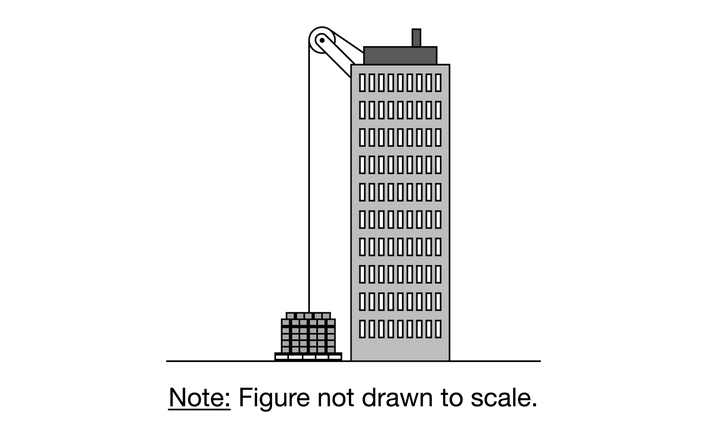Question
A 1000 W electric motor lifts a 100 kg safe at constant velocity. The vertical distance through which the motor can raise the safe in 10 s is most nearly
(A) 1 m
(B)3 m
(C) 10 m
(D) 32 m
(E) 100 m
Answer/Explanation
Ans:C
Question
An electric car of mass 300 kg delivers 400 W as it moves the car at a constant 20 m/s. The force delivered by the motor is
(A) \(\frac{4}{3} N\)
(B) 20 N
(C) 600 N
(D) 6,000 N
(E) 8,000 N
Answer/Explanation
Ans: B
Power is equal to the rate work is done and also the dot product of force and velocity.
P = Fv
400 W = F (20 m/s)
F = 20 N
Question
A space shuttle is launched from Earth. As it travels up, it moves at a constant velocity of 150 m/ s straight up. If its engines provide \(1.5 x 10^8\) W of power, what is the shuttle’s mass? You
may assume that the shuttle’s mass and the acceleration due to gravity are constant.
(A) \(6.7 X 10^2\) kg
(B) \(1.0 x 10^5\) kg
(C) \(6.7 x 10^5\) kg
(D) \(1.0 x 10^6\) kg
(E) \(2.3 x 10^6\) kg
Answer/Explanation
Ans: B
P=Fv=mgv
m = P/(gv)
\(= (1.5 x 10^8 W)/[(10 m/s^2 )(150 m/s)] = 1.0 x 10^5 kg\)
Question
A 200-W motor lifts an object at a constant speed of 0.5 m/s. The object ends up 100 m east of where it started and elevated 100 m vertically from its starting point after 20 seconds of elapsed time. What is the mass of the object?
(A) 2\(\sqrt{2}\) kg
(B) 4\(\sqrt{2}\) kg
(C) 0.2 kg
(D) 4 kg
(E) 8 kg
Answer/Explanation
Ans:
D—Power P is work done per time. The motor must do work to change the object’s potential energy by mgh, where h is 100 m. (Not 100\(\sqrt{2}\) m, because the h in this formula represents vertical height only. No work is done to carry the object horizontally.) The relevant equation becomes \(P=\frac{mgh}{t}\), where t is the 20-s time interval. Solving, \(m=\frac{Pt}{gh}\). That’s (200 W)(20 s) / (10 m/s/s) (100 m) = 4 kg.
Question

A pile of bricks of mass M is being raised to the tenth floor of a building of height H = 4y above the ground by a crane that is on top of the building. During the first part of the lift, the crane lifts the bricks a vertical distance \(h_1=3y\) in a time \(t_1=4T\). During the second part of the lift, the crane lifts the bricks a vertical distance \(h_2=y\) in \(t_2=T\). Which of the following correctly relates the power \(P_1\) generated by the crane during the first part of the lift to the power \(P_2\) generated by the crane during the second part of the lift?
A \(P_2=4P_1\)
B \(P_2=\frac{4}{3}P_1\)
C \(P_2=P_1\)
D \(P_2=\frac{3}{4}P_1\)
E \(P_2=\frac{1}{3}P_1\)
Answer/Explanation
Ans:B
Using the equation for power for the first part of the lift, \(P_1=\frac{W}{t}=\frac{mgh}{t}=\frac{mg(3y)}{(4T)}=\frac{3mgy}{4T}\) . For the second part of the lift, \(P_2=\frac{W}{t}=\frac{mgh}{t}=\frac{mg(y)}{(T)}=\frac{mgy}{T}\); thus, \(P1=\frac{3mgy}{4T}=\frac{3}{4}P_2\rightarrow P_2=\frac{4}{3}P_1\)